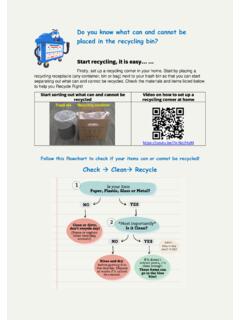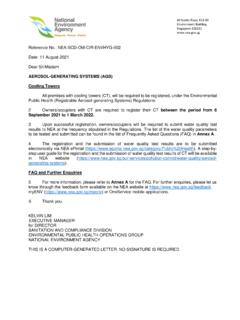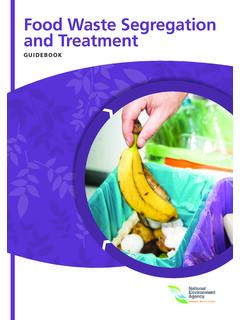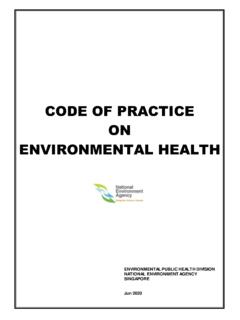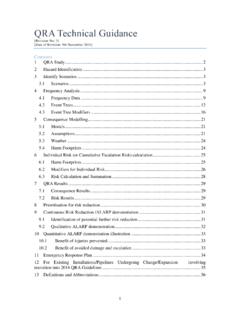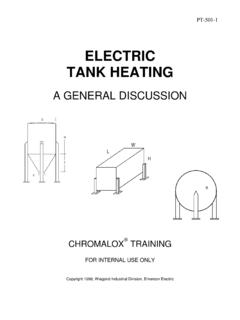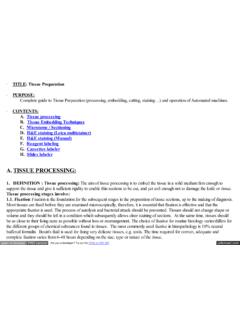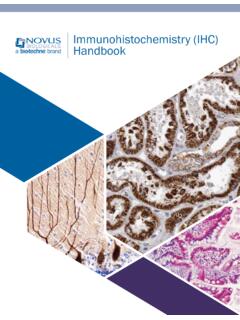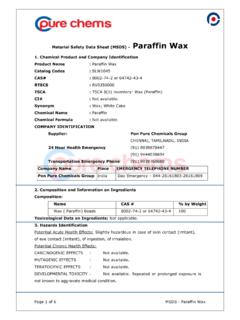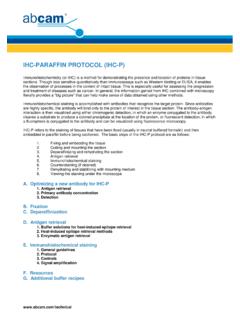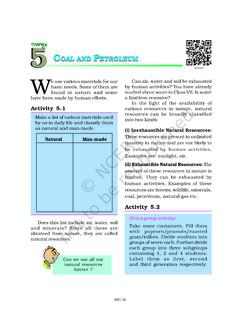Transcription of Greenhouse Gas (GHG) Emissions Measurement and …
1 1 Greenhouse Gas (GHG) Emissions Measurement and Reporting Guidelines APPENDIX TO PART II: MONITORING PLAN VERSION 14 FEB 2018 2 1. Purpose This Appendix is to be used in conjunction with the Greenhouse Gas Emissions Measurement and Reporting (GHG M&R) Guidelines Part II: Monitoring Plan. It supports the key M&R requirements and GHG computation approaches as explained in the Guidelines. Chapter 2 details the applicable Emissions quantification methods for common emission sources in Singapore as defined and provided in the Monitoring Plan Template (MP Template). Chapter 3 details the default uncertainty values for the default Measurement instruments listed in the MP Template.
2 Chapter 4 contains the list of remaining IPPU emission sources and their emission stream types which are less common in Singapore. The Emissions quantification methods ( Method 1: Calculation Approach, Method 2: Material Balance and Method 3: Direct Measurement ) in terms of the formulae, configurations in the MP Template, default conversion factors and uncertainty values provided in this Appendix are referenced and adapted from various sources the IPCC 2006 Guidelines, API Compendium, the National Greenhouse and Energy Reporting (NGER) ( Measurement ) Determination 2008 under the Australian NGER Act, as well as industry expert judgment and experience.
3 The configurations in the MP Template (based on the applicable Emissions quantification methods for the common emission sources) provided in the form of screenshots in this Appendix are only an indicative guide on how the MP Template could be completed, and are not exemplars of the MP Template. Facilities are advised to fill in the MP Template based on their own Emissions sources and Emissions quantification methods. 3 2. Common Emission Sources Based on the GHG M&R Guidelines Part II: Monitoring Plan and the MP Template, the types of processes or activities resulting in Greenhouse gas Emissions are broadly categorised into (i) fuel combustion and (ii) industrial processes and product use (IPPU).
4 This chapter details the applicable Emissions quantification methods for the following common emission sources under (i) fuel combustion and (ii) IPPU as defined and provided in the MP Template. Enhancements from the ECA Energy Use Report (GHG Section) The types of IPPU emission sources are referenced from the ECA Energy Use Report (EUR) (GHG from non-fuel combustion processes or activities) IPPU Emission Spreadsheet, which was prepared in accordance with the 2006 IPCC Guidelines. However, the following broad enhancements were made: i) Classifying Fugitive Emissions from oil and natural gas systems from venting, flaring, oil, and natural gas production and upgrading, natural gas processing, natural gas transmission and storage, transport of oil, oil refining, oil and natural gas distribution into three emission sources: (i) Flares, (ii) Vents, and (iii) Fugitive Emissions ; ii) Addition of new emission source: Coal Gasification; iii) Merging of Use of lubricant and Use of paraffin wax into one emission source: Use of lubricants or paraffin waxes.
5 And iv) Renaming of Use of HFCs and PFCs in fire protection equipment to: Use of GHGs in fire protection equipment, which includes carbon dioxide (CO2). For detailed enhancements for each emission source, please refer to the respective sections. Emission sources and emission stream types The list of common emission sources and their emission stream types are tabulated as follow. Emission source Emission stream type Section reference Fuel Combustion User-specified Table 3 Tier 1 default fuel combustion conversion factors and uncertainty values Section Industrial processes and product use (IPPU) Ethylene oxide production Page 17 Section Ethylene production Page 24 Section Flares Page 31 Section Vents Table 9 Emission stream types for vents Section 4 Emission source Emission stream type Section reference Fugitive Emissions Table 11 Emission stream types for fugitive Emissions Section Coal gasification User-specified Section Integrated circuit or semiconductor production Page 58 Section Thin-film-transistor flat panel display (TFT-FPD) or liquid crystal display (LCD)
6 Production Page 64 Section Iron and steel production Page 67 Section Use of GHGs in fire protection equipment Page 72 Section Use of HFCs or PFCs in refrigeration and air-conditioning equipment Page 74 Section Use of HFCs and PFCs in solvents Page 77 Section Use of lubricants or paraffin waxes Page 79 Section Use of SF6 in electrical equipment Page 83 Section Any other process or activity resulting in GHG Emissions User-specified Section Reporting status of parameters For each emission stream, a reporting status is assigned to each parameter of the formula used to compute Emissions .
7 The reporting status indicates whether the parameter is a constant, to be reported or calculated in the Emissions Report in the Emissions Data Monitoring and Analysis (EDMA) system. Reporting status Definition Calculated Automatically calculated by the EDMA system ( the final GHG Emissions value) Reported Parameter is to be reported by the facility in the Emissions Report, and they are usually parameters necessary for the quantification of GHG Emissions ( activity data or conversion factors when using Method 1: Calculation Approach, GHG Emissions when using Method 3: Direct Measurement ) Constant Parameter is constant ( global warming potential) and usually not required to be reported in the Emissions Report Definition of industrial process and fuel combustion Emissions According to international reporting guidelines, it is necessary to separate and allocate Emissions from fuel combustion ( F1, F2 in Tab C.)
8 Site Details of the MP Template) and IPPU ( P1, P2 in Tab C. Site Details of the MP Template) accordingly in both the MP Template and Emissions Report. 5 Based on the 2006 IPCC Guidelines1, the definition below aims to separate the combustion of fuels for producing energy, from the use of hydrocarbons in chemical reactions defining an IPPU process. Fuel combustion is defined as: the intentional oxidation of materials within an apparatus that is designed to provide heat or mechanical work to a process, or for use away from the apparatus. Examples below may help to illustrate the definition: If surplus methane or hydrogen from the steam cracking of naphtha is combusted within the petrochemical site for another process, then the Emissions are reported as Emissions from IPPU.
9 On the other hand, if the gases are passed to a nearby refinery for fuel use, the associated Emissions would be reported under fuel If waste gases, including CO2 components, from industrial processes are channelled to heat recovery systems and combusted as fuel, the combustible and non-combustible components are to be segregated and reported separately as Emissions from fuel combustion and IPPU respectively. For IPPU Emissions , as far as possible, the reporting of Emissions should be allocated to the specific and appropriate IPPU processes defined in the MP Template ( Ethylene production, Ethylene oxide production, Coal gasification etc.)
10 However, if facilities are unable to locate the specific IPPU processes defined in the MP Template for their emission source, the facility would have to report these Emissions under the emission source Any other process or activity resulting in Greenhouse gas Emissions . 1 Refer to the 2006 IPCC Guidelines, Volume 3, Chapter 1, sub-section on page and box on page for more details. 6 Fuel combustion Method 1: Calculation Approach Method 2: Material Balance Method 3: Direct Measurement The list of emission stream types for fuel combustion is based on the type of fuel as defined in the 2006 IPCC Guidelines.



